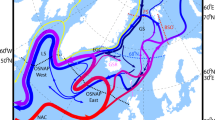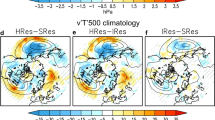Abstract
Atmospheric processes regulate the formation of deep water in the subpolar North Atlantic Ocean and hence influence the large-scale ocean circulation1. Every year thousands of mesoscale storms, termed polar lows, cross this climatically sensitive region of the ocean. These storms are often either too small or too short-lived to be captured in meteorological reanalyses or numerical models2,3,4. Here we present simulations with a global, eddy-permitting ocean/sea-ice circulation model, run with and without a parameterization of polar lows. The parameterization reproduces the high wind speeds and heat fluxes observed in polar lows as well as their integrated effects, and leads to increases in the simulated depth, frequency and area of deep convection in the Nordic seas, which in turn leads to a larger northward transport of heat into the region, and southward transport of deep water through Denmark Strait. We conclude that polar lows are important for the large-scale ocean circulation and should be accounted for in short-term climate predictions. Recent studies3,4 predict a decrease in the number of polar lows over the northeast Atlantic in the twenty-first century that would imply a reduction in deep convection and a potential weakening of the Atlantic meridional overturning circulation.
This is a preview of subscription content, access via your institution
Access options
Subscribe to this journal
Receive 12 print issues and online access
$259.00 per year
only $21.58 per issue
Buy this article
- Purchase on Springer Link
- Instant access to full article PDF
Prices may be subject to local taxes which are calculated during checkout




Similar content being viewed by others
References
Marshall, J. & Schott, F. Open-ocean convection: Observations, theory, and models. Rev. Geophys. 37, 1–64 (1999).
Condron, A., Bigg, G. R. & Renfrew, I. A. Polar mesoscale cyclones in the Northeast Atlantic: Comparing climatologies from ERA-40 and satellite imagery. Mon. Weath. Rev. 134, 1518–1533 (2006).
Kolstad, E. W. & Bracegirdle, T. J. Marine cold-air outbreaks in the future: An assessment of IPCC AR4 model results for the Northern Hemisphere. Climate Dynam. 30, 871–885 (2008).
Zahn, M. & von Storch, H. Decreased frequency of North Atlantic polar lows associated with future climate warming. Nature 467, 309–312 (2010).
Harold, J. M., Bigg, G. R. & Turner, J. Mesocyclone activity over the northeast Atlantic. Part 1: Vortex distribution and variability. Int. J. Climatol. 19, 1187–1204 (1999).
Bracegirdle, T. J. & Gray, S. L. An objective climatology of the dynamical forcing of polar lows in the Nordic seas. Int. J. Climatol. 28, 1903–1919 (2008).
Zahn, M. & Storch, H. von. A long-term climatology of North Atlantic Polar Lows. Geophys. Res. Lett. 35, L22702 (2008).
Jungclaus, J. H., Macrander, A. & Kase, R. H. in Arctic-Subarctic Ocean Fluxes: Defining the Role of the Northern Seas in Climate (eds Dickson, R. R., Meincke, J. & Rhines, P.) 527–549 (Springer, 2008).
Shapiro, M. A., Fedor, L. S. & Hampel, T. Research aircraft measurements of a polar low over the Norwegian Sea. Tellus 37A, 272–306 (1987).
Condron, A., Bigg, G. R. & Renfrew, I. A. Modelling the impact of polar mesoscale cyclones on ocean circulation. J. Geophys. Res. 113, C10005 (2008).
Saetra, O., Linders, T. & Deberbard, J. B. Can polar lows lead to a warming of the ocean surface? Tellus A 60, 141–153 (2008).
Moore, G.W.K., Reader, M.C., York, J. & Sathiyamoorthy, S. Polar lows in the Labrador Sea: A case study. Tellus 48A, 17–40 (1996).
Rasmussen, E. A. & Turner, J. Polar Lows: Mesoscale Weather Systems in the Polar Regions (Cambridge Univ. Press, 2003).
IPCC Climate Change 2007: The Physical Science Basis (eds. Solomon, S. et al.) (Cambridge Univ. Press, 2007).
Marshall, J., Adcroft, A., Hill, C., Perelman, L. & Heisey, C. A finite-volume, incompressible Navier Stokes model for studies of the ocean on parallel computers. J. Geophys. Res. 102, 5753–5766 (1997).
Schweckendiek, U. & Willebrand, J. Mechanisms affecting the overturning response in global warming simulations. J. Clim. 18, 4925–4936 (2005).
Dickson, R. R., Meincke, J. & Rhines, P. Arctic-Subarctic Ocean Fluxes: Defining the role of the northern seas in climate (Springer, 2008).
Nastrom, G. D. & Gage, K. S. A climatology of atmospheric wavenumber spectra of wind and temperature observed by commercial aircraft. J. Atmos. Sci. 42, 950–960 (1985).
Patoux, J. & Brown, R. A. Spectral analysis of QuikSCAT surface winds and two-dimensional turbulence. J. Geophys. Res. 106, 23995–24005 (2001).
Macrander, A., Send, U., Valdimarsson, H., Jonsson, S. & Kase, R. H. Interannual changes in the overflow from the Nordic Seas into the Atlantic Ocean through Denmark Strait. Geophys. Res. Lett. 32, L06606 (2005).
Biastoch, A., Kase, R. H. & Stammer, D. B. The sensitivity of the Greenland–Scotland ridge overflow to forcing changes. J. Phys. Oceanogr. 33, 2307–2319 (2003).
Langehaus, H. R., Medhaug, I., Eldevik, T. & Helge-Ottera, O. Arctic/Atlantic exchanges via the subpolar gyre. J. Clim. 25, 2421–2439 (2012).
Treguier, A. M. et al. The North Atlantic subpolar gyre in four high-resolution models. J. Phys. Oceanogr. 35, 757–774 (2005).
Pickart, R. S., Spall, M. A., Ribergaard, M. H., Moore, G. W. K. & Milliff, R. F. Deep convection in the Irminger Sea forced by the Greenland tip jet. Nature 424, 152–156 (2003).
Rhein, M. Convection in the Greenland Sea, 1982–1993. J. Geophys. Res. 101, 18183–18192 (1996).
Schlosser, P., Bonisch, G., Rhein, M. & Bayer, R. Reduction of deepwater formation in the Greenland Sea during the 1980s: Evidence from Tracer Data. Science 251, 1054–1056 (1991).
Acknowledgements
The authors would like to thank G. R. Bigg, B. Harden, D. P. Stevens, G. W. K. Moore and P. E. Isachsen for useful discussion and comments. We acknowledge the ECMWF for providing the ERA-40 fields. The numerical model integrations used resources of the National Energy Research Scientific Computing Center, which is supported by the US DOE Office of Science under Contract No. DE-AC02-05CH11231.
Author information
Authors and Affiliations
Contributions
A.C. and I.A.R. jointly conceived the study. A.C. adapted the parameterization scheme and carried out the model runs and model output analysis. I.A.R. carried out the spectral analysis of the wind fields. A.C. and I.A.R. jointly interpreted the results and wrote the manuscript.
Corresponding author
Ethics declarations
Competing interests
The authors declare no competing financial interests.
Supplementary information
Supplementary Information
Supplementary Information (PDF 498 kb)
Rights and permissions
About this article
Cite this article
Condron, A., Renfrew, I. The impact of polar mesoscale storms on northeast Atlantic Ocean circulation. Nature Geosci 6, 34–37 (2013). https://doi.org/10.1038/ngeo1661
Received:
Accepted:
Published:
Issue Date:
DOI: https://doi.org/10.1038/ngeo1661
This article is cited by
-
On Surface Waves in Arctic Seas
Boundary-Layer Meteorology (2023)
-
Global forestation and deforestation affect remote climate via adjusted atmosphere and ocean circulation
Nature Communications (2022)
-
Discrepancies in Simulated Ocean Net Surface Heat Fluxes over the North Atlantic
Advances in Atmospheric Sciences (2022)
-
The impact of wintertime sea-ice anomalies on high surface heat flux events in the Iceland and Greenland Seas
Climate Dynamics (2020)
-
Impacts of High-Frequency Atmospheric Forcing on Southern Ocean Circulation and Antarctic Sea Ice
Advances in Atmospheric Sciences (2020)



